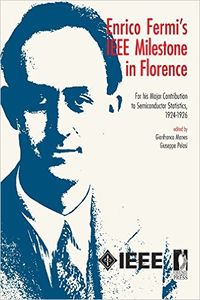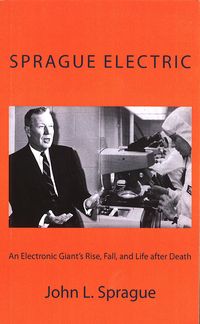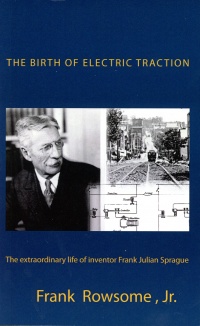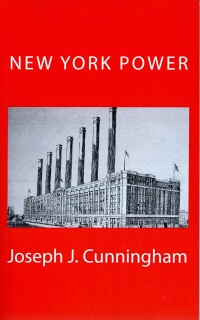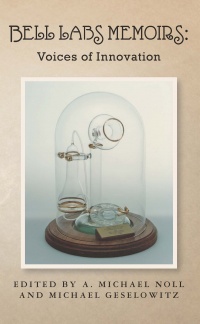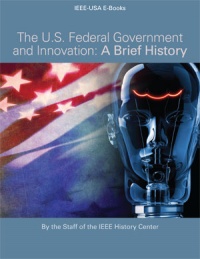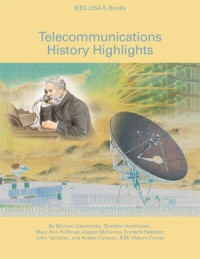Archives:IEEE History Center Book Publishing: Difference between revisions
No edit summary |
mNo edit summary |
||
| (54 intermediate revisions by 4 users not shown) | |||
| Line 1: | Line 1: | ||
IEEE History Center staff also publish journal articles. To go to a page of books and historical journal articles by History Center staff and others, please [http://ethw.org/Archives:Books_and_Archival_Publications click here]. | |||
[ | ''To see articles on the history of technology written by IEEE History Center staff for '''IEEE-USA Insight,''' [http://insight.ieeeusa.org/web/insight/list/-/content-list/category/29300 please click here].'' | ||
==Author Submission Guidelines== | |||
[[ | If you are interested in being one of our book authors, please see [[Archives:History Center Press Book Author Submission Guidelines|Author Submission Guidelines]]. | ||
[ | If you are interested in writing a history article for ''Proceedings of the IEEE'' in the 'Scanning our Past' department, please see [http://ethw.org/Archives:Proceedings_of_the_IEEE_%E2%80%9CScanning_the_Past%E2%80%9D_call_for_authors ''Proceedings'' author guidelines]. | ||
==Current Books== | |||
[[Image:Fermi front cover amazon.jpg|thumb|right|200px]] | |||
[ | |||
[[Image:Sprague Electric cover.jpg|thumb|right|200px]] | |||
[[Image:Electric Traction cover Feb 2014.jpg|thumb|right|200px]] | |||
[[Image:Cunningham cover hard copy001.jpg|thumb|right|200px]] | |||
[[Image:Bell Labs cover cropped.jpg|thumb|right|200px]] | |||
[[Image:USInnovationCover.jpg|thumb|right|200px]] | |||
[[Image:Telecommunications ebook cover.jpg|thumb|right|200px]] | |||
As part of its mission to bring the history of technology to a wide audience, the IEEE History Center publishes books as well as journal articles. | |||
== | ''[http://www.amazon.com/Enrico-Fermis-IEEE-Milestone-Florence/dp/1522870903/ref=sr_1_6?s=books&ie=UTF8&qid=1453394939&sr=1-6&keywords=fermi+semiconductor Enrico Fermi's Semiconductor Milestone in Florence]'' | ||
The | Nobel laureate Enrico Fermi developed the quantum statistics that would be named after him while teaching at the School of Engineering of the University of Florence. The Fermi-Dirac statistics were a fundamental contribution to semiconductor physics and to the development of electronics. The two original 1926 papers are reproduced in full in this book. This book commemorates the dedication in December 2015 of a [http://ethw.org/Milestones:Enrico_Fermi%27s_Major_Contribution_to_Semiconductor_Statistics,_1924-1926 Milestone] in Electrical Engineering and Computing by IEEE at the University of Florence in commemoration of Fermi's contribution. | ||
''[http://www.amazon.com/Sprague-Electric-Electronics-Giants-after/dp/150338781X/ref=sr_1_2?ie=UTF8&qid=1429202871&sr=8-2&keywords=sprague+electric Sprague Electric: An Electronics Giant's Rise, Fall, and Life after Death]'' | |||
''Sprague Electric: An Electronic Giant's Rise, Fall, and Life after Death'' by John L. Sprague. The rise of the Sprague Electric Company from a kitchen-table high-tech startup is representative of much of the U.S. electronics industry. Sprague Electric Company rose to become a thriving manufacturer employing thousands of workers, and building a broad product line with international sales and a reputation for the highest quality. It then declined, went through a series of acquisitions, and eventually dissolved. Yet today, many former Sprague Electric business units thrive as successful parts of other corporations. | |||
Sprague Electric's business and technological history serves as a lens for thousands of companies all over the world. It is the story of corporate success...and a tale of what to avoid. Told by company insider John Sprague, it gives the reader a front-row seat.<br> | |||
<br> | |||
<br> | |||
''[http://www.amazon.com/The-Birth-Electric-Traction-extraordinary/dp/1490955348/ref=sr_1_1?ie=UTF8&qid=1408394270&sr=8-1 The Birth of Electric Traction: The Extraordinary Life of Inventor Frank Julian Sprague] ''by Frank Rowsome Jr., available in paperback and Kindle® editions. | |||
Frank Julian Sprague has often been called the inventor of public transportation. In addition to his developments in electric traction, Sprague made enormous contributions in the areas of control and safety, without which mass transit would not be possible. Sprague developed automatic signal and brake control for railroads, and an auxiliary train control to take charge if the driver made a mistake. He was active in the planning and construction of New York City’s subway system, and in the electrification of Grand Central Terminal. | |||
Sprague believed that “Transportation is the key of civilization…for without it our existing social structure would collapse.” Among Sprague's other achievements are the introduction of electric elevators and of electric power units suitable for machine tools, printing presses, dentist's drills, and labor-saving conveniences in the home. | |||
Rowsome’s engaging and colorful biography not only gives a detailed view of Sprague as a person, but also Sprague’s approach to design and problem-solving. Numerous personal, and sometimes quite humorous, anecdotes bring Sprague, his assistants, and the early history of electric railroads to life. | |||
Frank Rowsome Jr. is probably now most famous for ''The Verse by the Side of the Road'' (1966), but he was also managing editor of ''Popular Science Monthly'' and later became NASA’s chief of technical publications. | |||
[http://www.amazon.com/New-York-Power-Joseph-Cunningham/dp/1484826515/ref=pd_sim_b_1?ie=UTF8&refRID=0NHHM2VRYYZXY55AX21F New York Power]'' by Joseph J. Cunningham, available in paperback and Kindle® editions. '' | |||
New York City’s density placed unique constraints on its electric light and power supply. Electrification began during the 1880s, but many innovations were required to supply urban service at a cost that would make possible large-scale consumption. ''New York Power'' tells the story of the electrification of the one of the densest electrical load areas in the world, it was also where alternating current challenged and then ultimately vanquished the original direct-current system. Author Joseph J. Cunningham has consulted a variety of historical sources to bring us the story of the massive and sustained effort to develop New York City’s electric utility system. He has researched and authored numerous articles and books on topics such as industrial electrification and electric rail transportation, and has taught widely on the history of electric power systems and consulted on numerous electro-technology projects and television productions. Lionel Trains has consulted him for the historical details of its model trains. | |||
''[http://www.amazon.com/Bell-Labs-Memoirs-Innovation-Geselowitz/dp/1463677979/ref=sr_1_1?s=books&ie=UTF8&qid=1320151019&sr=1-1 Bell Labs Memoirs: Voices of Innovation]'', edited by A. Michael Noll and Michael Geselowitz is now available in paperback and Kindle® editions. | |||
The innovative spirit and creative energy of Bell Labs during the directorship of William Baker are described by twelve people who worked there. The culture of Bell Labs comes to life through the first-hand accounts of [[John Pierce|John Pierce]], father of communications satellites; [[Manfred R. Schroeder|Manfred Schroeder]], speech encoding pioneer; [[Walter L. Brown|Walter Brown]], developer of silicon semiconductors; [[Carol G. Maclennan|Carol Maclennan]], expert in spacecraft communications and data analysis; [[Alan G. Chynoweth|Alan Chynoweth]], materials research authority; [[David Dorsi|David Dorsi]], expert glassblower; [[Edward E. Zajac|Edward Zajac]], submarine cables and economics research; [[Edwin A. Chandross|Edwin Chandross]], optical memories and organic materials (inventor of the now ubiquitous light stick); [[Italo Quinto|Italo Quinto]], chauffeur to William Baker; [[Man Mohan Sondhi|Mohan Sondhi]], inventor of the adaptive echo canceller; [[William L. Keefauver|William Keefauver]], Bell Labs’ general patent attorney; and lastly, [[William O. Baker|William Baker]] himself. | |||
The research done at Bell Labs led to many devices and techniques that helped build our present world. Acoustic cameras, adaptive predictive coding, block diagram compilers, cryptography, diamond crystal research, digital communication, echo research, inverse filtering, light-emitting diodes (LEDs), magnetic bubble memories, microwaves, organic field effect transistors, pulse code modulation, synthetic speech, transistors, traveling-wave tubes, and vocoders are among the topics recalled by the contributors to this book. [http://www.amazon.com/Bell-Labs-Memoirs-Innovation-Geselowitz/dp/1463677979/ref=sr_1_1?s=books&ie=UTF8&qid=1320151019&sr=1-1 Available now]. | |||
'''The IEEE History Center is also pleased to remind readers of the availability of two previous e-publications, produced in partnership with IEEE-USA E-Books:''' | |||
a) ''The US Federal Government and Innovation - A Brief History'' - This book briefly outlines, for engineers and policymakers, the history of U.S. government involvement in technological innovation, from Morse's telegraph and radio to transistors, computing, and lithium batteries. | |||
[http://www.ieeeusa.org/communications/ebooks/info.asp?Keyword=innovation&Product=The+US+Federal+Government+and+Innovation+-+A+Brief+History#= Member Price: $4.79, Non-member Price: $5.99] | |||
''b) History of Telecommunications'' - Telecommunications has been one of the most influential technologies in human history. As the speed and volume of the transmission of messages increased, history itself has been made and altered. Telecommunications has not only influenced history, it has also allowed us to share and participate in historical events. This book is a collection of articles written by the staff of the IEEE History Center highlighting some of the many triumphs in the world of telecommunications. | |||
[http://www.ieeeusa.org/communications/ebooks/info.asp?Keyword=History&Product=Telecommunications+%2D+History+Highlights Member Price: $4.79, Non-member Price: $5.99] | |||
'''The book publishing program is made possible in large part by donations. If you have enjoyed our books, please consider supporting the IEEE History Center’s work by making a donation to the''' [https://www.ieee.org/organizations/foundation/DonateOnline.html#%7C IEEE Foundation - History Center Fund]. | |||
[[Category:IEEE | [[Category:Communications]] | ||
[[Category:Computing_and_electronics]] | |||
[[Category:Energy]] | |||
[[Category:Lasers,_lighting_&_electrooptics]] | |||
[[Category:Profession]] | |||
[[Category:People_and_organizations]] | |||
[[Category:IEEE]] | |||
[[Category:Transportation]] | |||
Latest revision as of 01:19, 2 October 2020
IEEE History Center staff also publish journal articles. To go to a page of books and historical journal articles by History Center staff and others, please click here.
To see articles on the history of technology written by IEEE History Center staff for IEEE-USA Insight, please click here.
Author Submission Guidelines
If you are interested in being one of our book authors, please see Author Submission Guidelines.
If you are interested in writing a history article for Proceedings of the IEEE in the 'Scanning our Past' department, please see Proceedings author guidelines.
Current Books
As part of its mission to bring the history of technology to a wide audience, the IEEE History Center publishes books as well as journal articles.
Enrico Fermi's Semiconductor Milestone in Florence
Nobel laureate Enrico Fermi developed the quantum statistics that would be named after him while teaching at the School of Engineering of the University of Florence. The Fermi-Dirac statistics were a fundamental contribution to semiconductor physics and to the development of electronics. The two original 1926 papers are reproduced in full in this book. This book commemorates the dedication in December 2015 of a Milestone in Electrical Engineering and Computing by IEEE at the University of Florence in commemoration of Fermi's contribution.
Sprague Electric: An Electronics Giant's Rise, Fall, and Life after Death
Sprague Electric: An Electronic Giant's Rise, Fall, and Life after Death by John L. Sprague. The rise of the Sprague Electric Company from a kitchen-table high-tech startup is representative of much of the U.S. electronics industry. Sprague Electric Company rose to become a thriving manufacturer employing thousands of workers, and building a broad product line with international sales and a reputation for the highest quality. It then declined, went through a series of acquisitions, and eventually dissolved. Yet today, many former Sprague Electric business units thrive as successful parts of other corporations.
Sprague Electric's business and technological history serves as a lens for thousands of companies all over the world. It is the story of corporate success...and a tale of what to avoid. Told by company insider John Sprague, it gives the reader a front-row seat.
The Birth of Electric Traction: The Extraordinary Life of Inventor Frank Julian Sprague by Frank Rowsome Jr., available in paperback and Kindle® editions.
Frank Julian Sprague has often been called the inventor of public transportation. In addition to his developments in electric traction, Sprague made enormous contributions in the areas of control and safety, without which mass transit would not be possible. Sprague developed automatic signal and brake control for railroads, and an auxiliary train control to take charge if the driver made a mistake. He was active in the planning and construction of New York City’s subway system, and in the electrification of Grand Central Terminal.
Sprague believed that “Transportation is the key of civilization…for without it our existing social structure would collapse.” Among Sprague's other achievements are the introduction of electric elevators and of electric power units suitable for machine tools, printing presses, dentist's drills, and labor-saving conveniences in the home.
Rowsome’s engaging and colorful biography not only gives a detailed view of Sprague as a person, but also Sprague’s approach to design and problem-solving. Numerous personal, and sometimes quite humorous, anecdotes bring Sprague, his assistants, and the early history of electric railroads to life.
Frank Rowsome Jr. is probably now most famous for The Verse by the Side of the Road (1966), but he was also managing editor of Popular Science Monthly and later became NASA’s chief of technical publications.
New York Power by Joseph J. Cunningham, available in paperback and Kindle® editions.
New York City’s density placed unique constraints on its electric light and power supply. Electrification began during the 1880s, but many innovations were required to supply urban service at a cost that would make possible large-scale consumption. New York Power tells the story of the electrification of the one of the densest electrical load areas in the world, it was also where alternating current challenged and then ultimately vanquished the original direct-current system. Author Joseph J. Cunningham has consulted a variety of historical sources to bring us the story of the massive and sustained effort to develop New York City’s electric utility system. He has researched and authored numerous articles and books on topics such as industrial electrification and electric rail transportation, and has taught widely on the history of electric power systems and consulted on numerous electro-technology projects and television productions. Lionel Trains has consulted him for the historical details of its model trains.
Bell Labs Memoirs: Voices of Innovation, edited by A. Michael Noll and Michael Geselowitz is now available in paperback and Kindle® editions.
The innovative spirit and creative energy of Bell Labs during the directorship of William Baker are described by twelve people who worked there. The culture of Bell Labs comes to life through the first-hand accounts of John Pierce, father of communications satellites; Manfred Schroeder, speech encoding pioneer; Walter Brown, developer of silicon semiconductors; Carol Maclennan, expert in spacecraft communications and data analysis; Alan Chynoweth, materials research authority; David Dorsi, expert glassblower; Edward Zajac, submarine cables and economics research; Edwin Chandross, optical memories and organic materials (inventor of the now ubiquitous light stick); Italo Quinto, chauffeur to William Baker; Mohan Sondhi, inventor of the adaptive echo canceller; William Keefauver, Bell Labs’ general patent attorney; and lastly, William Baker himself.
The research done at Bell Labs led to many devices and techniques that helped build our present world. Acoustic cameras, adaptive predictive coding, block diagram compilers, cryptography, diamond crystal research, digital communication, echo research, inverse filtering, light-emitting diodes (LEDs), magnetic bubble memories, microwaves, organic field effect transistors, pulse code modulation, synthetic speech, transistors, traveling-wave tubes, and vocoders are among the topics recalled by the contributors to this book. Available now.
The IEEE History Center is also pleased to remind readers of the availability of two previous e-publications, produced in partnership with IEEE-USA E-Books:
a) The US Federal Government and Innovation - A Brief History - This book briefly outlines, for engineers and policymakers, the history of U.S. government involvement in technological innovation, from Morse's telegraph and radio to transistors, computing, and lithium batteries.
Member Price: $4.79, Non-member Price: $5.99
b) History of Telecommunications - Telecommunications has been one of the most influential technologies in human history. As the speed and volume of the transmission of messages increased, history itself has been made and altered. Telecommunications has not only influenced history, it has also allowed us to share and participate in historical events. This book is a collection of articles written by the staff of the IEEE History Center highlighting some of the many triumphs in the world of telecommunications.
Member Price: $4.79, Non-member Price: $5.99
The book publishing program is made possible in large part by donations. If you have enjoyed our books, please consider supporting the IEEE History Center’s work by making a donation to the IEEE Foundation - History Center Fund.
